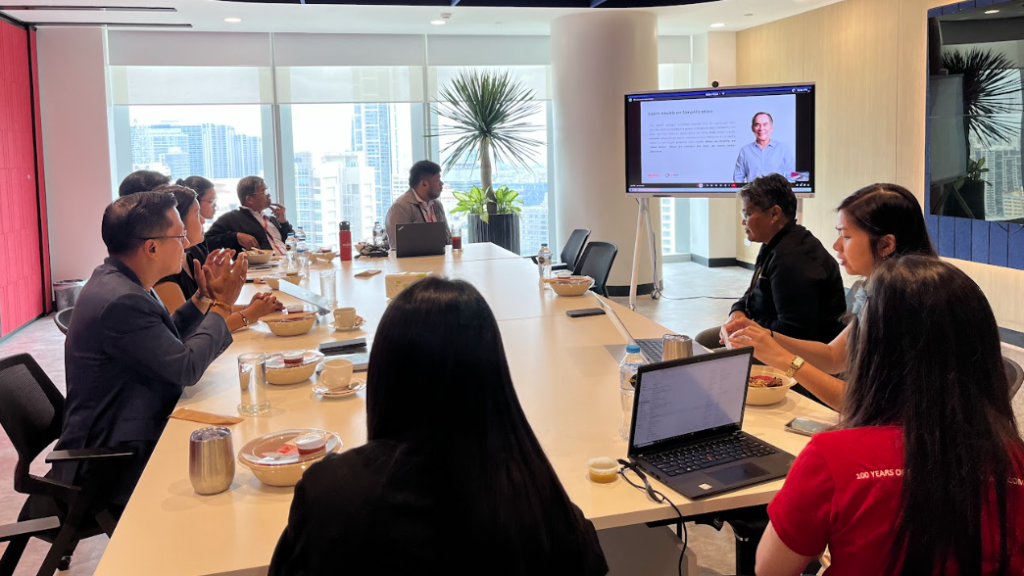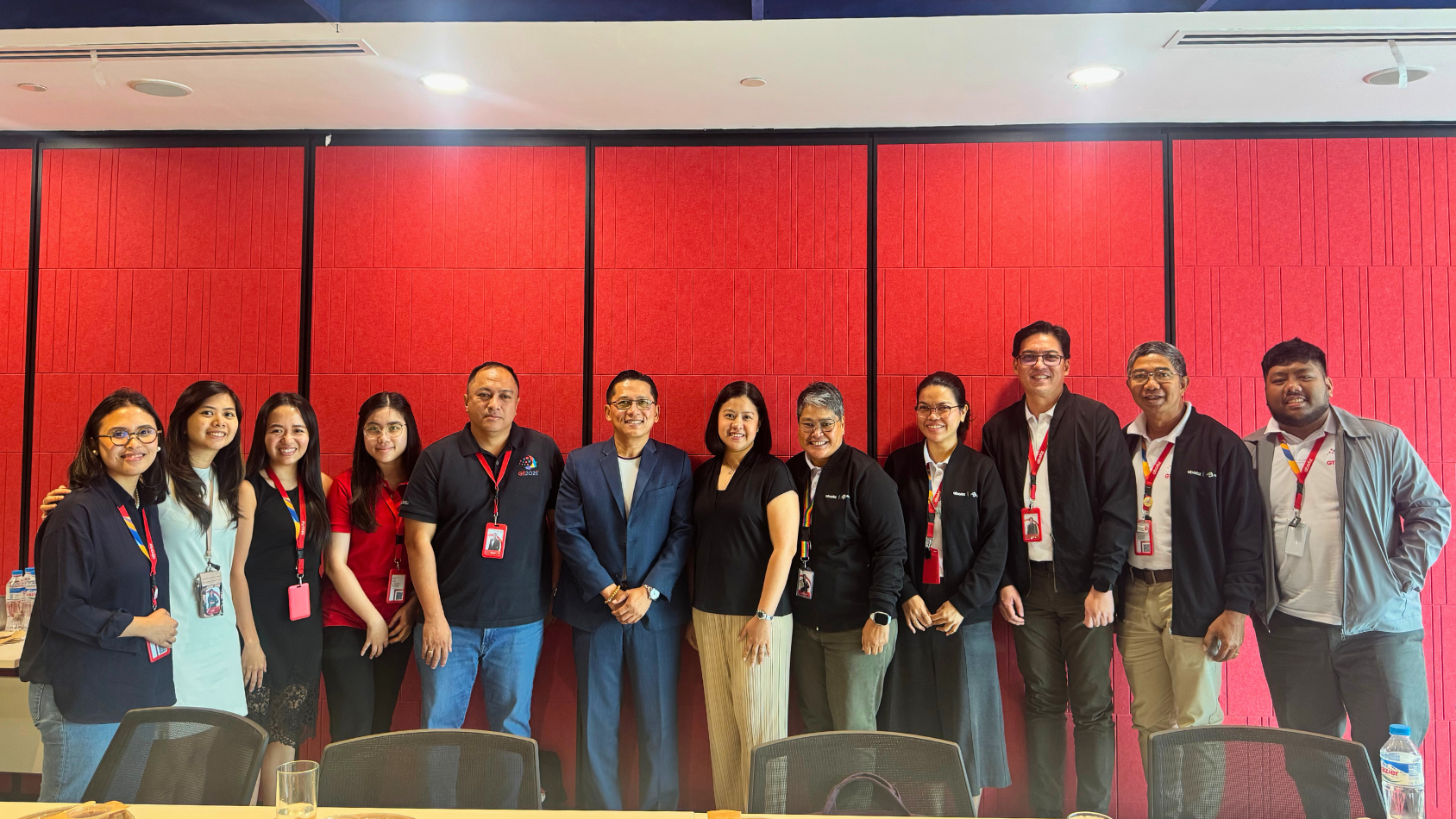The session participants from Aboitiz Equity Ventures with featured GT speaker, UnionBank Chief Transformation Officer Dennis Omila and Vice President for Enterprise Architecture Michelle Rodriguez.
By Bianca Gempesaw
What does it take to simplify a bank? For UnionBank, they treat simplification as a design choice, embedding clarity, speed, and purpose into decisions. At Transformative Digest #4, Chief Transformation Officer Dennis Omila showed how that discipline structures complexity, empowers teams, and drives impact.
Discomfort as a Starting Point
One of Omila’s most compelling insights was deceptively simple: “If a process feels uncomfortable, it’s probably not designed well.” Discomfort signals opportunity—a prompt to rethink, improve, and act.
Embracing discomfort requires not just discipline, but also a mindset grounded in entrepreneurial behavior and the value of caring like an owner—where employees are encouraged to spot inefficiencies, take initiative, and lead improvements from wherever they stand.
As UnionBank’s digital transformation matured, simplification was deliberately embedded into the bank’s architecture principles, roadmaps, and enterprise strategy.
“It was a response to the growing complexity of systems, processes, and stakeholder expectations,” Dennis shared. “We realized that simplification was essential to accelerate decision-making, improve efficiency, enhance customer experience, and enable scalable innovation.”
Clarity Through Architecture and Automation
UnionBank began this discipline in 2017 with its digital transformation. It shaped the automation strategy, embedding simplification into core processes through end-to-end mapping, reusable components, and design principles like straight-through processing and 24/7 reliability. By targeting inefficiencies such as paper use, hand-offs, and redundant approvals, teams built smarter, scalable workflows that worked smarter–not harder.
In consumer lending, straight-through processing now covers 80%+ of applications, cutting onboarding to 5–15 minutes. UnionBank onboards thousands of applications monthly; automation drives 30–40% of credit decisioning, reducing manual touchpoints and errors.
“We reviewed every system and asked—does it add value or just create noise?” said Michelle Rodriguez, VP for Enterprise Architecture. “Simplification meant cutting redundancies and aligning teams around a leaner, more agile ecosystem.”
Another major leap: Introduced in 2020, UnionBank’s award-winning Mobile Check Deposit (MCD) lets customers deposit checks anytime, anywhere using a smartphone. letting customers deposit checks via smartphone that eliminated counter visits and streamlining corporate workflows. In the first half of 2025, the group led the mobile check deposit market with 60% share.
This mindset extended to the systems behind those workflows. Through Application Portfolio Rationalization (APR), the team uncovered widespread duplication and rationalized its system landscape, decommissioning 100+ apps, reengineering 116, and achieving over Php 100M in savings through a future-fit portfolio.
As the team put it, “APR didn’t just cut costs, it enabled faster deployments, reduced technical debt, and improved governance.” For customers and stakeholders, this means faster service, smoother digital experiences, and scalable innovation delivered at lower cost.
“One of the biggest ‘aha’ moments was realizing just how many apps were duplicating the same functions, particularly in HR, reconciliation, and document management,” the team shared.
The four cost transformation drivers contributed Php600+M in savings:
- War on SMS — ₱181M (unit-cost renegotiation; shorter/eliminated SMS/OTP)
- OSP Rationalization — ₱200M+ (vs ₱120M target) across Tech & Ops
- AWS Optimization/FinOps — ₱190M+ (vs ₱100M target)
- App/Tech Portfolio Rationalization — ₱56M (terminations, license rationalization, negotiations)
Making Simplification Stick

While systems provide structure, culture drives sustainability. Omila emphasized that transformation succeeds when simplification becomes everyone’s responsibility, not just IT or Tech’s. Over time, simplification became a daily discipline—practiced, refined, and owned across the organization.
“What surprised us was how quickly simplification became a shared language,” the team shared. “It broke silos and helped people focus on more strategic, value-adding work.”
UnionBank knew transformation was about people. Guided by their strong belief that “No one gets left behind”, they prioritized upskilling, reduced resistance to change, and ensured continuity while providing psychological safety for employees as they went through the journey together. In the next chapter, they are moving forward with “AI to Fly” as their battlecry–signaling their commitment to building the next-generation bank of the country, powered by intelligent systems and empowered people.
Their advice:
- Communicate purpose: Make the ‘why’ clear and inspiring.
- Design for inclusion: Support all roles through change.
- Celebrate wins: Share stories of growth and progress.
“There is no real partnership without a common purpose,” the team added. “Collaboration leads to progressive transformation.” This mindset sustains itself—teams now continuously improve workflows without waiting for top-down direction.
As Chief Information Security Officer Charmaine Valmonte shared, “UnionBank’s commitment to embedding simplification into its culture made one thing clear: this isn’t just a tech challenge, it’s a leadership imperative. It’s a call to action for all of us to lead and work differently, every single day.”
Another attendee, Work Asset Management Manager RJ Garga, added, “Simplification isn’t just for digital teams. Even in Asset Management, we can rethink how we work smarter.”
Transformative Learning, Shared Forward
The session offered a blueprint for change that’s adaptable across teams and industries. For participants, it sparked reflection: what could simplification look like in their own work? UnionBank’s journey opened space for new questions and shared learning across the Aboitiz community.
And perhaps most importantly, the session reminded everyone that discomfort is not the enemy—it’s the beginning. Every clunky form or inefficient handoff is a chance to ask: Why is this hard and how can we improve it?
Simplification by design doesn’t just solve today’s problem. It builds tomorrow’s playbook for how we build, how we lead, and how we grow.


